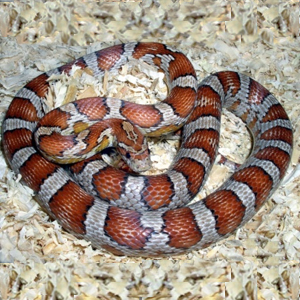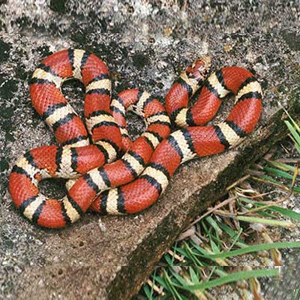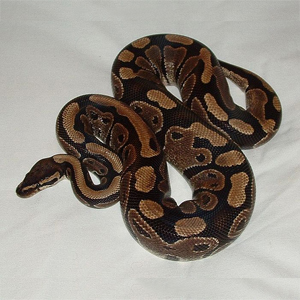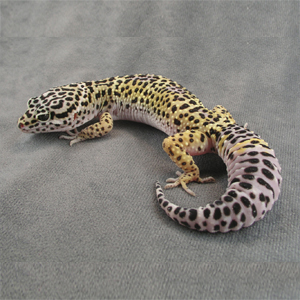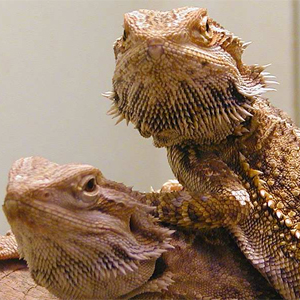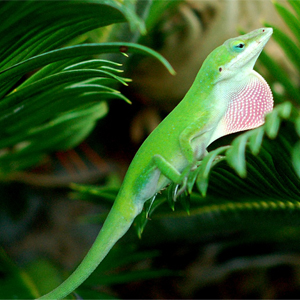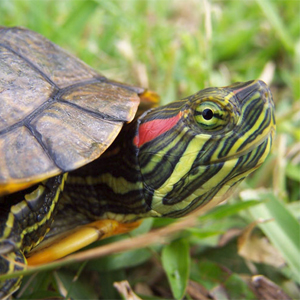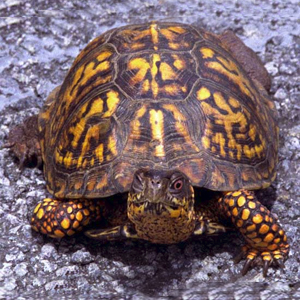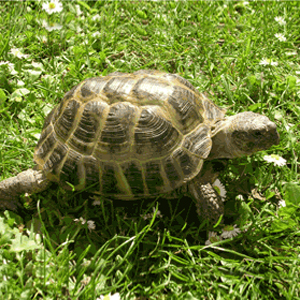Reptiles
Snakes
Snakes are fascinating, and with regular handling can be quite tame. However, snakes are obviously not the right pets for everyone. They have unique requirements and should only be kept by those with the commitment to understand and meet their needs. When choosing a snake, you are making a long term commitment - many can be expected to live longer than 20 years. You must be willing to feed prey animals to your snake (though frozen, pre-killed prey is the best choice), and you will probably have to devote some freezer space to frozen prey items (i.e. rodents).
Corn Snakes
Corn snakes (Elaphe guttata) make an excellent choice as a pet snake. Pet corn snakes are generally docile, relatively easy to care for, and do not get too large. They are excellent escape artists, however, so care must be taken when planning their housing.
King and Milk Snakes
King snakes and milk snakes are beautiful, quite docile snakes. Milk and king snakes are closely related, both belonging to the genus Lamproletis, and there are several subspecies of both king snakes and milk snakes. Colors and patterns vary between the subspecies, but there are many striking and beautiful patterns to be found among these snakes.
Ball Pythons
The ball python (Python regius) is a good snake for a beginning snake owner. Growing to a maximum size of 3-5 feet, ball pythons are not as large as many of the other constricting snakes that are kept as pets, and are quite docile and easy to handle. A captive bred ball python usually flourishes given the proper care.
You can learn more about Pet Snakes here: exoticpets.about.com
Lizards
These three Lizards are good for beginners. Because they are tolerant of mistakes, easy to care for and relatively inexpensive.
Leopard Gecko
The leopard gecko is a great lizard for beginners. It stays relatively small, doesn’t have a lot of space requirements, and is generally very tolerant of handling. It is very easy to take care of these lizards. You feed them 2 to 4 live crickets every other day, make sure their water is fresh, and the temperatures are maintained properly. They don’t require special UVA/B lighting because of the fact that they are nocturnal.
Bearded Dragon
The bearded dragon comes from Australia. There are actually seven different species of bearded dragon with Pogona vitticeps, or the Central (Inland) Bearded Dragon being the most commonly found in the pet trade. They can reach up to 2 feet in length and their tails accounts for over half of their size. You’ll also need an appropriate sized cage (a single adult dragon needs, at minimum, a 55 gallon enclosure), substrate, food (they are omnivores so need both meat and vegetables), heat source, and the proper UVA/B lighting.
Green Anole
One of the most commonly available lizards the green anole is also known as the American chameleon. They are not actually true chameleons (not a member of the Chamaeleonidae family) but they can change colors from a dull brown to an emerald green. They are very common in the state of Florida. They grow to be 8 to 9 inches. The male has a dewlap under its chin that it uses in courtship rituals and while making territorial displays.
A great source of Pet Lizard Information can be found here: pet-lizards.com
Turtles and Tortoises
Turtles and tortoises have rather long lifespans, which most people aren't prepared to deal with. When getting a turtle, it is truly a commitment, and not an animal that will die within a few years.
These animals, not only have a long lifespan, but they also require large enclosures. Even smaller species of turtles and tortoises, require larger enclosures- whether inside or out. It's important that they have a proper enclosure, as they need the exercise, and it's really important that tortoises get the outside time, as they need the UV, even if it's just for a few hours a few times a week; it's important.
The enclosure for a turtle or tortoise is very important, as without a proper size enclosure and setup, a pet turtle won't be a healthy turtle.
Red Ear Slider
Red ear sliders are native to parts of southern United States. They can be found near rivers and fishing docks of northern Florida to over halfway up the east coast through parts of Georgia and South Carolina, as well as west through the coast of Texas
An adult should be housed in at least a 40 gallon tank. The water needs to be about 75 to 85F, and because the species is semi-aquatic, they need a land area to bask, which should be about 90F. The basking temperatures can easily be provided by a UV heat lamp.
RES will eat an omnivorous diet, of aquatic plants and meat proteins. You can offer commercial pellet diets, but RES typically prefer minnows, earthworms, crickets, guppies, and aquatic snails. They can also be provided fresh plants, such as dandelions, endive, escarole, chicory, kale, sweet potato, zucchini, and green leaf lettuce.
Box Turtle
There are several locales of box turtles. In many cases, the Eastern Box turtle will be found in the pet trade, but the North American and Asian box turtles are also popular. These species can be found in various parts of the United States, as well as Asia.
In general, box turtles have an average lifespan of at least 40 years, but it's not uncommon to find a 100 year old box turtle.
These turtles do best when housed outside, but a large 50 gallon tank will suffice for one adult turtle. They generally do best with a basking site, enough substrate to burrow in, and high humidity. When outside, they love to swim and bask by a water source, so it may be ideal to set up a large outdoor pen with a kiddy pool with shallow water to swim in. Otherwise, when kept inside, you'll want to mist the tortoise, and soak it several times a week. When housing inside, you want to offer UV lighting Box turtles are omnivorous species, but they thrive on a high protein diet, especially within the first few years of life
Russian Tortoise
This species is smaller tortoise species, that is very popular among keepers. They are native to Afghanistan, Northern Pakistan, parts of Iran, and China. They can be found in sand and clay desserts with sparse grasses.
This tortoise can grow up to 10", but typically range to about 6 to 7" in length. They have average lifespans of 30+ years, so they are definitely a commitment.
One Russian tortoise can live in a 50 gallon tote as an adult, but they really should have an outdoor pen as well. Setting up a medium to large sized pen is ideal for them to get UV lighting and sun rays. This species does need UV, so when setting up an indoor pen, you'll want to provide a UV heat bulb, as well as any other supplemental heating to get the temperatures around 90-95F in the basking area.
These tortoises thrive on mixed grasses and weeds, as well as spring mix lettuces from the grocery store.
A good place to learn more about Turtles and Tortoises: Best-Pet-Turtle-and-Tortoise
